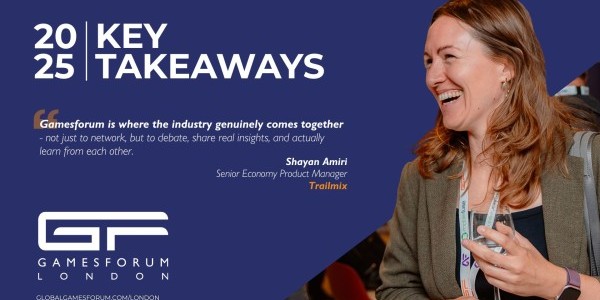Gamesforum Meets: Boram Ku, AppLovin’s Managing Director

In a conversation with Boram Ku, Head of AppLovin APAC, we explore her journey from the early days of social casino games to leading one of mobile gaming's powerhouse platforms across Asia. From Boram's start in a Korean gaming studio to guiding AppLovin’s strategic growth in APAC, Boram has seen the rise of Vietnam’s mobile gaming scene firsthand, witnessing its shift from hypercasual hits to hybrid-casual sophistication.
Ahead of her user acquisition panel at Gamesforum Vietnam, Boram shares insights into how AppLovin supports studios with advanced tools and tailored approaches across diverse markets, offering an inside look at where the industry is heading in 2025.
Great to reconnect with you Boram, can you tell us about yourself and your background in mobile gaming?
Hey John, glad to see you again too and thanks for having me today...and sure!
Hello, my name is Boram Ku, and I’m managing AppLovin APAC based out of Singapore. My first job in mobile gaming was with a gaming studio in Korea that made social casino games for Facebook Apps - remember those days? - and later with a mobile version of the title. I knew nothing about UA or social casino - I heard that word literally the first day I joined the company, though I later learned it was certainly the buzz word in the industry at that time. It was such an eye opening experience for me coming from a completely different background to see how users engage with other players in the game, how that affects online communities - which directly impacted business results, or even how one little change in creatives can make a huge difference in conversions, and down funnel metrics. Also, I’d say it was certainly one of the most fun and fascinating jobs I’d had in my life by that time! (because I played games so much for “market research” during my work hours! How cool is that?)
Then I moved on to a casual gaming studio also based in Korea - that’s I think when I saw you first at Gamesforum in London, then eventually became marketing director of that company where I managed the whole team of UA managers, creative designers, analysts to build BI systems, community managers and so on. One of the best parts of that job was that I got to meet so many great industry friends, and that led me to my moving to Singapore to join the MoPub team to lead their effort in Korea first then later managed the APAC team. And with that responsibility, I was extremely lucky to meet and work with incredible game developers all across APAC - another eye opening experience I’d say especially given how different markets within APAC, whether that be CN, KR, JP, VN, or IN behave so differently, which gave me enormous amount of exposure to different insights and understanding of each market.
And then in 2022, we all know what happened to MoPub.
Since January 2024, you’ve headed up the AppLovin team in APAC – how important is the region for AL’s growth strategy?
Yeah I started taking some more responsibility in 2024 but actually I joined AppLovin as head of JAPAC, BD, back in 2022 with the MoPub acquisition. My team at MoPub and I moved all together to build the AppLovin APAC team as AppLovin had teams with a small number of BDs spread across APAC markets such as Korea, Japan, and Vietnam, but didn’t have a, let’s say, APAC headquarter back then.
Now, how important APAC is to AppLovin - as we know, Applovin is one of the strongest platforms for gaming developers so mature regions like EMEA or China has always been strong, but when it comes to growth of each region, I’d say APAC is one of the fastest growing markets. Historically APAC was considered to be producing local games in most cases, like those strong IAP games from JP and KR targeting local markets. However, over the past few years we have been seeing incredible growth of global games coming from the APAC region in particular from Vietnam thanks to its ever exploding creativity and constant innovation - we see Vietnamese games regularly topping download charts and now coming up high in top grossing charts as well.
Also, while talking about APAC, it’s worth acknowledging some new players from emerging markets in the region, such as India and Pakistan, and we have been seeing some of the most incredible growth coming from these countries in recent months. So, definitely more to come in APAC!
With variations in markets intra-regionally, how does AppLovin adapt its offering to localities such as Vietnam?
As I briefly shared, AppLovin always believed in being in each local market rather than operating from remote locations, and also hiring and developing local talents. After my team and I joined from MoPub, our APAC regional base has been set in Singapore but our approach has never changed - that’s why my team is still spread across core countries in APAC like for instance Vietnam; but even within Vietnam, we have people in Hanoi and HCM where the majority of gaming studios are based. Though AppLovin is a US company, it has always focused on adjusting and tailoring our strategy for each core market since we understand that you cannot just come into these markets with the mindset and strategy we use in other regions.
Also, I travel to these markets as much as possible - or as much as my body can handle! After COVID, we do see that a lot of things can be done via video calls and chats and yes, a lot of things can be done virtually but even the slightest difference in time zone, or language, and not to mention subtle differences in cultures, can affect the efficiency of communications between us and our partners who talk on a daily basis to discuss campaign strategies, best practices, or market insights. And I might be old fashioned but I feel like there definitely is a difference in the level of engagement in person vs. online when we work with our partners. So, in short, being present in each market has always been our approach.
What stands out to you as unique about Vietnamese mobile games publishers?
Fast adaptation, constant innovation, and swift execution I’d say. The growth of the Vietnamese mobile gaming market is certainly one of the most phenomenal growths I’ve ever witnessed in my time in the industry and it is incredible how fast it is shifting and evolving.
Since the dawn of hyper-casual games years back, which led to the explosion of large gaming studios in Vietnam, these studios have been at the forefront of the growth of the region; then since late last year, they have been, again, leading the growth of this new trend: hybrid monetization - where a game monetizes not just from ads but with in app purchases. And that’s the reason why I mentioned those three points as the driving force of the growth of the market.
Let’s say when there was a surge of hyper casual games globally, we could easily see new studios popping up everyday and new games topping those charts overnight from Vietnam; whereas, in more mature markets in APAC, those changes came slower with of course lower number of new players in the game. (pun intended) This trend was also seen with the rise of hybrid casual games this year and we have some of the biggest global players such as OneSoft ABI or Zego or strong newcomers such as OneTap from Vietnam. More importantly, it isn’t just a fad as these games still perform and are growing post launch with constant improvements in game designs and new content, merging of concepts and mechanisms for example in puzzles, optimization of economy both from ads and IAPs, and ofc more sophisticated UA strategy, where it is all about performance, not just volume and low CPI from the hyper casual era.
How impressed have you been by the dynamism of the Vietnamese mobile gaming scene?
Super impressed. The only downside of witnessing this is that I feel older whenever I go back to Vietnam! I often find myself with fresh graduates in a meeting with our partners and see some of them grow into bigger roles and become experts in UA or ad monetization. Also, I see new studios founded by former members of partner companies I’ve worked with, and thanks to their extensive knowledge and experience in gaming, they become the next strong players in the market, and that’s the beautiful cycle of growth I’ve been observing. And because we have previous relationships in these studios, we already have good rapport and a good understanding of how they operate, which makes it easier for us to work together and be a close partner/consultant for their new business.
In that sense, it is extremely rewarding to work in Vietnamese mobile gaming and I truly enjoy seeing our partners grow.
What trends do you think it’s most important for Vietnamese publishers to be focussing on in 2025?
While 2024 has been all about shifting from hypercasual to hybrid-casual games, I already see some of the leading players in that genre getting more sophisticated with IAP side of things - meaning if they have games with an IAA-IAP ratio of revenue of let’s say 80:20 or 70:30, then they later release a game with similar concept but with a higher IAP portion such as 50:50 or even 30:70. What’s interesting about this is that it doesn’t just happen from 0 IAP to 50%, it usually started with the lighter version of the title, then even in that same game, publishers optimize further with higher IAP ratio, and deploy different UA strategies, then with the learnings from these iterations and experiments, they again release a new game. This could still be a similar concept, but with a different monetization mechanism featuring a much heavier IAP portion, which usually leads to higher LTV of the game. So, not like in those days with surging hypercasual games with short life cycles accelerated by constant new releases, these hybrid- casual publishers continue the growth of their relatively mature games while adding more titles with stronger IAP revenue on top of their existing portfolio, which leads to a stable growth of their business as a whole while diversifying their revenue stream, and I don’t think this trend will go away anytime soon and continue in 2025.
Another quick observation is, not just expanding to different game genres, but also to other categories such as non-gaming apps including those apps powered by AI in productivity or photo editing. Speaking of which, we’ll probably see more rapid adoption of AI in not just game development but in all aspects of operations; whether that be creatives using generative AI for UA, if not already, more customized in-game content based on what users a game is targeting, or further automation of BAU. Given how fast Vietnamese developers adopt these new technologies, things may look very different in a year or so.
What do you think is driving challenges in UA globally?
I think it always has been growing amidst fierce competition and making sure to reach the right audience for your games, not just in the financial perspective but also creating the ecosystem within the game where users can be more engaged and continuously play the games. Especially in hybrid monetization, it could be hard to expand the user base with various behaviors without complicating the operation too much - for example, as you can see with IAP-only advertisers with advanced segmentation of users with live ops, it could lead to operational workload if not careful. So, expanding the user base with efficient operation is also a key challenge to make your hybrid-casual games successful. This of course applies not just to hybrid-casual but a studio with various types of games.
Another challenge that came up at the beginning of this shift from hyper to hybrid-casual was that these publishers who only needed to look at D7 payback windows, now had to take the risk at the initial stage of scaling while not knowing if the campaigns would be profitable in the longer term, like D30, 60, 90+. But, as I mentioned earlier, as these publishers are getting more mature with this genre, they started building sound prediction models internally to make sure the games would be profitable even when there is a brand new game with only a week of data based on the previous growth trajectory they had observed with their similar games.
How is AppLovin assisting companies in meeting these challenges?
We are having quite an exciting year with the continuous advancement of our AI-powered engine with more options in targeting, which enables publishers to reach different segments of users following their KPIs more easily. We just published a fascinating case study from Vietnam actually about ABI’s Wood Nuts & Bolts puzzle title, looking at how they identified the opportunity of expanding their user base. During that time, my team also helped with the experiment by utilizing a campaign type that could target not just users who watch ads but also make in-app purchases - we call it a blended ROAS campaign. With this combination, they saw seven times higher payer conversion rate and 20% higher ROAS than that from the ad ROAS campaign that only targeted ad driven users. As their IAP was getting more optimized, they expanded to IAP targeting campaigns as well. Now this isn’t just ABI, but a general trend that I see from our top partners - while they optimize the games with more sophisticated monetization models, AppLovin has been helping with their multi campaign strategy that allows them to target different segments of users at the same time. With this, they could expand their user base and achieve more sustainable growth as they’re not only reliant on certain types of users or revenue sources. And the best part is - it is incredibly easy to manage those campaigns since we passed the stage of source targeting, frequent bid adjustments, etc.
AppLovin will be at Gamesforum Vietnam in a few weeks - what can we expect to hear?
AppLovin will be sharing insights and growth strategies in detail for various types of games at the upcoming Gamesforum Vietnam event!











